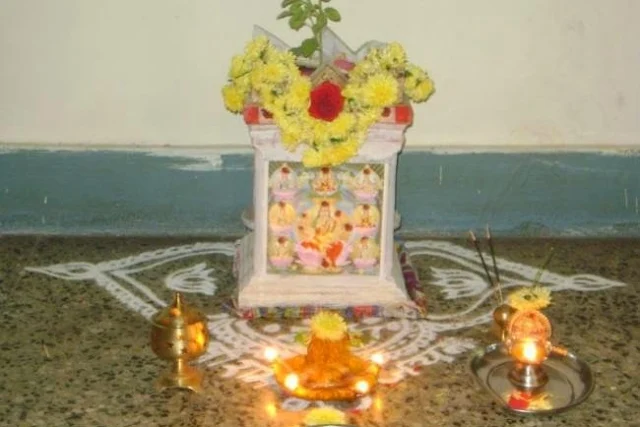Lalitha Sahasranama (lalitāsahasranāma) is a text from Brahmanda Purana. It is a sacred text to the Hindu worshippers of the Goddess Lalita Devi, i.e. the Divine Mother or Goddess Durga, in the form, Shakti. Lalitha is the Goddess of bliss, an epithet for Shiva's wife Goddess Parvati. Etymologically, "Lalitha" means "She Who Plays". In the root form (vyutpatti), the word "Lalitha" means "spontaneous" from which the meaning "easy" is derived and implicitly extends to "play".
Lalita Sahasranama, also known as the Lalitha Sahasranamam, is a Hindu text from the Brahmanda Purana. The Lalita Sahasranama is the thousand names of the Hindu mother goddess Lalita. It is a sacred text for the Hindu worshippers of the Goddess Lalita Devi, who considered to be a manifestation of the Divine Mother (Shakti), and the text is therefore used in the worship of Durga, Parvati, Kali, Lakshmi, Saraswati, Bhagavati, etc. as well. A principal text of Shakti worshipers, it names the goddess's various attributes in the form of names organized in a hymn. This sahasranama is used in various modes for the worship of the Divine Mother like parayana, archana, and homa.
Sri Lalitha Sahasranama Stotra and Meaning
Sri Lalitha Sahasranama Sthotram full in Lalitha Devi Image
Brahmasri Samavedam Shanmukha Sarma (26-June-1967– ) is a popular person on television in India, and well appreciated for his commentary/discourses on Rudra Namakam, Vishnu Sahasranamam, Sivanandalahari, Soundarya Lahari, Lalitha Sahasranamam, Siva Tatvam, Ganapathi Tatwam, Sri Krishna Tatwam, Ramayanam, Bhagavatam, the Bhagavad Gita, Mahabharatham, Dakshinamurti Tattvam, Sutha Samhitha, Aditya Hrdayam and the kritis of different Vaggeyakaras.
Lalita Sahasranama, also known as the Lalitha Sahasranamam, is a Hindu text from the Brahmanda Purana. The Lalita Sahasranama is the thousand names of the Hindu mother goddess Lalita. It is a sacred text for the Hindu worshippers of the Goddess Lalita Devi, who considered to be a manifestation of the Divine Mother (Shakti), and the text is therefore used in the worship of Durga, Parvati, Kali, Lakshmi, Saraswati, Bhagavati, etc. as well. A principal text of Shakti worshipers, it names the goddess's various attributes in the form of names organized in a hymn. This sahasranama is used in various modes for the worship of the Divine Mother like parayana, archana, and homa.
Sri Lalitha Sahasranama Stotra and Meaning
Sri Lalitha Sahasranama Sthotram full in Lalitha Devi Image
Brahmasri Samavedam Shanmukha Sarma (26-June-1967– ) is a popular person on television in India, and well appreciated for his commentary/discourses on Rudra Namakam, Vishnu Sahasranamam, Sivanandalahari, Soundarya Lahari, Lalitha Sahasranamam, Siva Tatvam, Ganapathi Tatwam, Sri Krishna Tatwam, Ramayanam, Bhagavatam, the Bhagavad Gita, Mahabharatham, Dakshinamurti Tattvam, Sutha Samhitha, Aditya Hrdayam and the kritis of different Vaggeyakaras.









